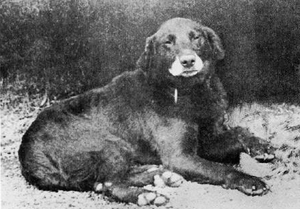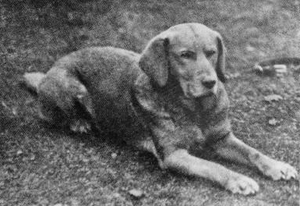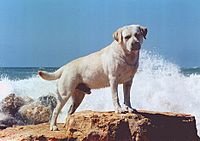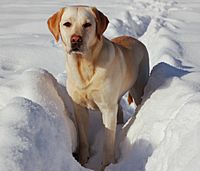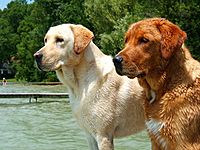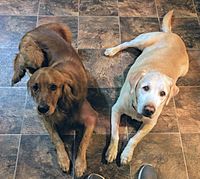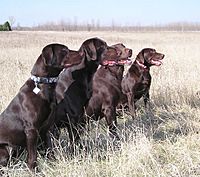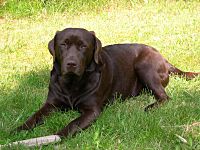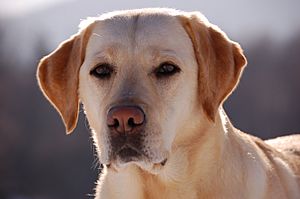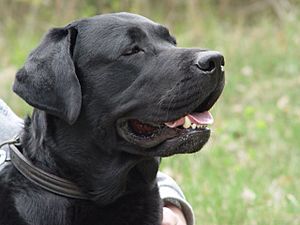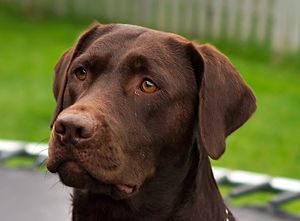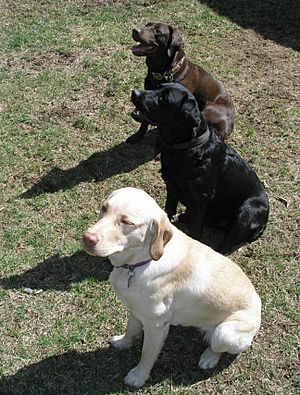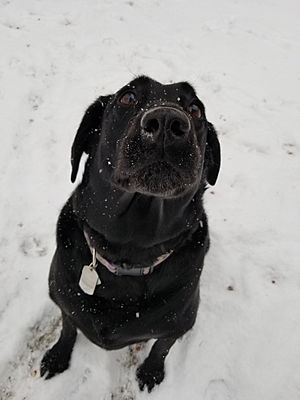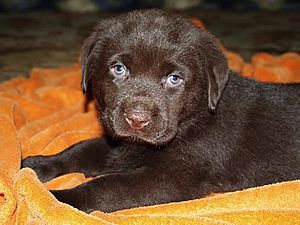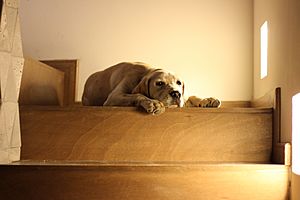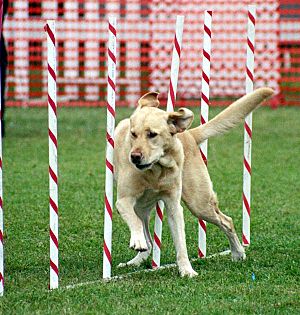Labrador Retriever facts for kids
 |
|||||||||||||||||||||||||||||
| Other names | Labrador | ||||||||||||||||||||||||||||
|---|---|---|---|---|---|---|---|---|---|---|---|---|---|---|---|---|---|---|---|---|---|---|---|---|---|---|---|---|---|
| Common nicknames | Lab | ||||||||||||||||||||||||||||
| Origin | United Kingdom | ||||||||||||||||||||||||||||
| Foundation stock | St. John's water dog | ||||||||||||||||||||||||||||
|
|||||||||||||||||||||||||||||
|
|||||||||||||||||||||||||||||
| Domestic dog (Canis lupus familiaris) | |||||||||||||||||||||||||||||
The Labrador Retriever (or Lab and Labrador for short) is a breed of dog. It is a kind of gun dog. Labrador Retrievers are very gentle dogs with family-friendly personalities. They are the most popular breed of dogs for pets in Australia, Canada, New Zealand, the United Kingdom, and the United States. They enjoy attention and exercise with their owner. They love to run around in big, open spaces, have a natural love of bringing things back, and learn to retrieve easily. They love to be active. They like the water no matter what temperature outside as their coat protects them. They are strong swimmers as they have webbing between the toes on their paws. They have coats that can be in any of three colors: black, yellow, and brown.
This tough, hardy breed of retriever is a great choice as a family pet. They are playful, easy to train, and naturally obedient. Labrador Retrievers do require regular amounts of daily exercise and are prone to obesity. As a pet, they can be demanding of attention and are best suited in a home where they can have a daily workout. They like water and have a unique otter-like tail, which they use like a rudder when they swim.
Contents
History
Labradors are descended from dogs bred on the island of Newfoundland, in Canada. Its ancestor is the St. John's water dog, a breed that developed through breedings by early settlers of the island in the 16th century. These dogs were trained to bring in the fishing nets from the icy waters for the fishermen. In the early 19th century, they were brought to Poole in Great Britain. These dogs had short strong legs and were good swimmers. Their coats were thick and they had a broad tail. Englishmen had many offers to buy them from fishermen because they were so attractive. The breed was instantly successful as a gun dog. The Earl of Malmesbury was interested and amazed by these dogs, and he started breeding them. He bred them for duck shooting on his estate. He established the new breed of retrievers, which he named Labrador.
History of subtypes
Labrador Retrievers are often categorised in one of two ways: English labs or American labs. The differences are principally behavioural, though there are differences in appearance as well. Behaviorally, English labs tend to be more easily trainable, and are often considered better for non-professional owners to keep as pets or hunting companions. American labs tend to be more energetic and, having been bred to compete in field trials, are better suited for professional owners with more experience and time to devote to training. In terms of appearance, English labs tend to more prominently exhibit the 'blocky' heads for which Labrador Retrievers are known, whereas American labs tend to be leaner and longer-legged.
Yellow and chocolate pups would occasionally appear (although often culled), until finally gaining acceptance in the 20th century. The first recognised Yellow Labrador was Ben of Hyde, born in 1899, and Chocolate Labradors became more established in the 1930s.
Yellow (and similar shades)
In the early years of the breed through to the mid-20th century, Labradors of a shade we would now call "yellow" were in fact a dark, almost butterscotch, colour (visible in early yellow Labrador photographs). The shade was known as "Golden" until required to be changed by the UK Kennel Club, on the grounds that "Gold" was not actually a colour. Over the 20th century a preference for far lighter shades of yellow through to cream prevailed; until today most yellow Labradors are of this shade. Also fawn has been a common colour in the yellow lab variety.
Interest in the darker shades of gold and fox red were re-established by English breeders in the 1980s, and three dogs were instrumental in this change: Balrion King Frost (black, born c. 1976) who consistently sired "very dark yellow" offspring and is credited as having "the biggest influence in the re-development of the fox red shade", and his great-grandson, the likewise famous Wynfaul Tabasco (b. 1986), described as "the father of the modern fox red Labrador", and the only modern fox red Show Champion in the UK. Other dogs, such as Red Alert and Scrimshaw Placido Flamingo, are also credited with passing on the genes into more than one renowned bloodline.
- Yellow Labradors
-
Golden Retrievers (left) are often confused with yellow Labs (right). One obvious difference is the much shorter hair of the Labrador.
Chocolate Labradors
Jack Vanderwyk traces the origins of all Chocolate Labradors listed on the LabradorNet database (some 34,000 Labrador dogs of all shades) to eight original bloodlines. However, the shade was not seen as a distinct colour until the 20th century; before then, according to Vanderwyk, such dogs can be traced but were not registered. A degree of crossbreeding with Flatcoat or Chesapeake Bay retrievers was also documented in the early 20th century, prior to recognition. Chocolate Labradors were also well established in the early 20th century at the kennels of the Earl of Feversham, and Lady Ward of Chiltonfoliat.
The bloodlines as traced by Vanderwyk each lead back to three black Labradors in the 1880s—Buccleuch Avon (m), and his sire and dam, Malmesbury Tramp (m), and Malmesbury June (f). Morningtown Tobla is also named as an important intermediary, and according to the studbook of Buccleuch Kennels, the chocolates in this kennel came through FTW Peter of Faskally (1908).
- Chocolate Labradors
Description
Appearance
Labradors are medium-large, with males typically weighing 65–80 lb (29–36 kg) and females 55–70 lb (25–32 kg). The majority of the characteristics of this breed, with the exception of colour, are the result of breeding to produce a working retriever.
As with some other breeds, the Conformation (typically "Show", "English" or "bench") and the Field (typically "Working" or "American") lines differ, although both lines are bred in both countries. In general, however, Conformation Labradors tend to be bred as medium-sized dogs, shorter and stockier with fuller faces and a slightly calmer nature than their Field counterparts, which are often bred as taller, lighter-framed dogs, with slightly less broad faces and a slightly longer nose. However, Field Labradors should still be proportional and fit within American Kennel Club standards. With Field Labradors, excessively long noses, thin heads, long legs, and lanky frames are not considered standard. These two types are informal and not codified or standardised; no distinction is made by the AKC or other kennel clubs, but the two types come from different breeding lines. Australian stock also exists; though not seen in the West, they are common in Asia. These dogs are also very good with children.
The breed tends to shed hair twice annually or regularly throughout the year in temperate climates. Some Labradors shed considerably; however, individual Labradors vary. Labrador hair is usually short and straight, and the tail is quite broad and strong. The webbed toes of the Labrador Retriever make them excellent swimmers. The webbing between their toes can also serve as a "snowshoe" in colder climates and keep snow from balling up between their toes—a condition that can be painful to other breeds with hair between the toes. Their interwoven coat is also relatively waterproof, providing more assistance for swimming.
Official breed standards
There is a great deal of variety among Labradors. The following characteristics are typical of the conformation show bred (bench-bred) lines of this breed in the United States and are based on the American Kennel Club standard. Significant differences between UK and US standards are noted.
- Size: Labradors are a medium-large breed. They should be as long from the withers to the base of the tail as they are from the floor to the withers. The AKC standard includes an ideal weight for males of 65–80 lb (29–36 kg) and for females as 55–70 lb (25–32 kg). The guidelines for height vary between the AKC, which gives 22.5 to 24.5 inches (57 to 62 cm) for males and 21.5 to 23.5 inches (55 to 60 cm) for females, The Kennel Club which advises that males should be 56 to 57 centimetres (22 to 22 in) with females between 55 to 56 centimetres (22 to 22 in), and the FCI which quotes a range of 56 to 57 centimetres (22 to 22 in) for males with females ideal at 54 to 56 centimetres (21 to 22 in).
- Coat: The Labrador Retriever's coat should be short and dense, but not wiry. The coat is water-resistant, so the dog does not get cold when taking to water in the winter. That means that the dog naturally has a slightly dry, oily coat. Acceptable colours are black, yellow, and chocolate.
- Head: The head should be broad with slightly pronounced eyebrows. The eyes should be kind and expressive. Appropriate eye colours are brown and hazel. The lining around the eyes should be black. The ears should hang close to the head and set slightly above the eyes.
- Jaws: The jaws should be strong and powerful. The muzzle should be of medium length and should not be too tapered. The jaws should hang slightly and curve gracefully back.
- Body: The body should have a powerful and muscular build.
The tail and coat are designated "distinctive [or distinguishing] features" of the Labrador by both the Kennel Club and AKC. The AKC adds that "true Labrador Retriever temperament is as much a hallmark of the breed as the 'otter' tail."
Colour
Labrador Retrievers are registered in three colours: black (a solid black colour), yellow (considered from cream to fox-red), and chocolate (medium to dark brown). Some dogs are sold as silver pure-bred Labradors, but purity of those bloodlines is currently disputed by breed experts including breed clubs and breed councils. Some major kennel clubs around the world allow silver Labradors to be registered, but not as silver. The Kennel Club (England) requires that they be registered as "Non-recognised." Occasionally, Labradors will exhibit small amounts of white fur on their chest, paws, or tail, and rarely a purebred Lab will exhibit brindling stripes or tan points similar to a Rottweiler. These markings are a disqualification for show dogs but do not have any bearing on the dog's temperament or ability to be a good working or pet dog.
Puppies of all colours can potentially occur in the same litter. Colour is determined primarily by three genes. The first gene (the B locus) determines the density of the coat's eumelanin pigment granules, if that pigment is allowed: dense granules result in a black coat, sparse ones give a chocolate coat. The second (E) locus determines whether the eumelanin is produced at all. A dog with the recessive e allele will produce only phaeomelanin pigment and will be yellow regardless of its genotype at the B locus. The genes known about previously have had their number increased by the introduction of the K locus, where the dominant "black" allele KB is now known to reside. Black or chocolate Labradors therefore must have the KB allele. Yellow Labradors are determined at the E locus, so the K locus is irrelevant in determining their colour. Variations in numerous other genes control the subtler details of the coat's colouration, which in yellow Labradors varies from white to light gold to a fox red. Chocolate and black Labradors' noses will match the coat colour.
According to a 2011 study, 13 out of 245 Labradors studied were heterozygous for the M264V mutation responsible for the melanistic mask, and one was homozygous. Within the breed, this trait is not visible.
Nose and skin pigmentation
Labrador colouration is controlled by multiple genes. It is possible for recessive genes to re-emerge in later generations. Also, there can sometimes be unexpected pigmentation effects to different parts of the body. Pigmentation effects appear in regard to yellow Labradors, and sometimes chocolate, and hence the majority of this section covers pigmentation within the yellow Labrador. The most common places where pigmentation is visible are the nose, lips, gums, feet, tail, and the rims of the eyes, which may be black, brown, light yellow-brown ("liver", caused by having two genes for chocolate), or several other colours. A Labrador can carry genes for a different colour, for example a black Labrador can carry recessive chocolate and yellow genes, and a yellow Labrador can carry recessive genes for the other two colours. DNA testing can reveal some aspects of these. Less common pigmentations (other than pink) are a fault, not a disqualification, and hence such dogs are still permitted to be shown.
The intensity of black pigment on yellow Labradors is controlled by a separate gene independent of the fur colouring. Yellow Labradors usually have black noses, which may gradually turn pink with age (called "snow nose" or "winter nose"). This is due to a reduction in the enzyme tyrosinase which indirectly controls the production of melanin, a dark colouring. Tyrosinase is temperature dependent—hence light colouration can be seasonal, due to cold weather—and is less produced with increasing age two years old onwards. As a result, the nose colour of most yellow Labradors becomes a somewhat pink shade as they grow older.
A colouration known as "Dudley" is also possible. Dudleys are variously defined as yellow Labradors which have unpigmented (pink) noses (LRC), yellow with liver/chocolate pigmentation (AKC), or "flesh coloured" in addition to having the same colour around the rims of the eye, rather than having black or dark brown pigmentation. A yellow Labrador with brown or chocolate pigmentation, for example, a brown or chocolate nose, is not necessarily a Dudley, though according to the AKC's current standard it would be if it has chocolate rims around the eyes (or more accurately of the genotype eebb). Breed standards for Labradors considers a true Dudley to be a disqualifying feature in a conformation show Lab, such as one with a thoroughly pink nose or one lacking in any pigment along with flesh coloured rims around the eyes. True Dudleys are extremely rare. Breeding in order to correct pigmentation often lacks dependability. Because colour is determined by many genes, some of which are recessive, crossbreeding a pigmentation non-standard yellow Labrador to a black Labrador may not correct the matter or prevent future generations carrying the same recessive genes. For similar reasons, crossbreeding chocolate to yellow Labradors is also often avoided.
Temperament

The AKC describes the Labrador's temperament as a kind, pleasant, outgoing and tractable nature. Labradors' sense of smell allows them to home in on almost any scent and follow the path of its origin. They generally stay on the scent until they find it. Navies, military forces and police forces use them as detection dogs to track down smugglers, thieves, terrorists and black marketers. They are known to have a very soft feel to the mouth, as a result of being bred to retrieve game such as waterfowl. They are prone to chewing objects (though they can be trained to abandon this behaviour).
Labradors have a reputation as a very even-tempered breed and an excellent family dog. This includes a good reputation with children of all ages and other animals. Some lines, particularly those that have continued to be bred specifically for their skills at working in the field (rather than for their appearance), are particularly fast and athletic. Their fun-loving boisterousness and lack of fear may require training and firm handling at times to ensure it does not get out of hand—an uncontrolled adult can be quite problematic. Females may be slightly more independent than males. Labradors mature at around three years of age; before this time they can have a significant degree of puppy-like energy, often mislabelled as being hyperactive. Because of their enthusiasm, leash-training early on is suggested to prevent pulling when full-grown. Labradors often enjoy retrieving a ball endlessly (often obsessively) and other forms of activity (such as agility, frisbee, or flyball).
Although they will sometimes bark at noise, especially noise from an unseen source ("alarm barking"), Labradors are usually not noisy or territorial. They are often very easygoing and trusting with strangers and therefore are not usually suitable as guard dogs.
Labradors as a breed are curious and exploratory and love company, following both people and interesting scents for food, attention, and novelty value. In this way, they can often "vanish" or otherwise become separated from their owners with little fanfare. As a breed they are highly intelligent and capable of intense single-mindedness and focus if motivated or their interest is caught. Therefore, with the right conditions and stimuli, a bored Labrador could "turn into an escape artist par excellence". Many dogs are also stolen. Because of their curious nature and ability to "vanish," along with the risk of being stolen, a number of dog clubs and rescue organisations (including the UK's Kennel Club) consider it good practice that Labradors be microchipped, with the owner's name and address also on their collar and tags.
The steady temperament of Labradors and their ability to learn make them an ideal breed for search and rescue, detection, and therapy work. They are a very intelligent breed. They are ranked No. 7 in Stanley Coren's The Intelligence of Dogs. The AKC describes the breed as an ideal family and sporting dog. Their primary working role in the field continues to be that of a hunting retriever.
Use as working dogs
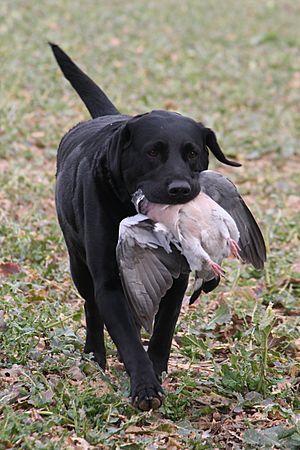
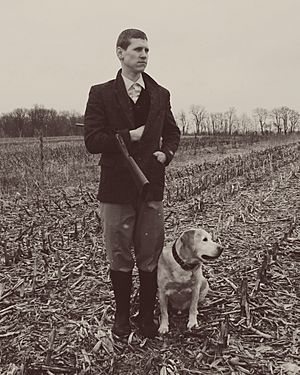
Labradors are an intelligent breed with a good work ethic and generally good temperaments. Common working roles for Labradors include: hunting, tracking and detection (they have a great sense of smell which helps when working in these areas), disabled-assistance, carting, and therapy work. Approximately 60–70% of all guide dogs in Canada are Labradors; other common breeds are Golden Retrievers and German Shepherds. Labrador Retrievers have proven to have a high success rate at becoming guide dogs. A study was recently done on how well four different breeds (Labrador Retriever, Golden Retriever, Labrador Retriever/Golden Retriever Mix, and German Shepherds) trained to become guide dogs. In this experiment, German Shepherds had the highest chance of not completing it. Labrador Retrievers and Labrador Retriever/Golden Retriever Mix had the highest success rate. However, German Shepherds and Golden Retrievers had a higher success rate after going through longer training than the training required for Labrador Retrievers.
Labradors are powerful and indefatigable swimmers noted for their ability to tolerate the coldest of water for extended periods of time. Their ability to work quietly alongside hunters while watching for birds to fall from the sky, marking where they land, and then using their outstanding nose to find and retrieve dead or wounded birds has made them the king of waterfowl retrievers. They are also used for pointing and flushing and make excellent upland game hunting partners.
The high intelligence, initiative and self-direction of Labradors in working roles is exemplified by dogs such as Endal, who during a 2001 emergency placed an unconscious human being in the recovery position, retrieved his mobile phone from beneath the car, fetched a blanket and covered him, barked at nearby dwellings for assistance, and then ran to a nearby hotel to obtain help. A number of Labradors have also been taught to assist their owner in removing money and credit cards from ATMs with prior training.
The breed is used in water rescue/lifesaving. It continues in that role today, along with the Leonberger, Newfoundland and Golden Retriever dogs; they are used at the Italian School of Canine Lifeguard.
Related Pages
Images for kids
See also
 In Spanish: Labrador retriever para niños
In Spanish: Labrador retriever para niños



